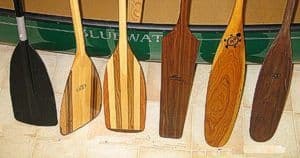Canoe Paddle Care
Have you checked the price of canoe paddles lately? Good ones cost over $100; great ones approach $300 — and they're worth it. But at these prices, they better last a long time. Here's how to make your favorite paddles last almost forever:
STORAGE AND TRANSIT
Wooden paddles may warp if stored flat or stacked helter-skelter in a barrel. A good method for home storage is to tie short cords around the grips and hang them from nails or pegs. Scratches and gouges that break the finish of wooden paddles should be repaired as soon as possible. Polyurethane varnish is fast and easy, but marine spar varnish is much tougher.

Preparation: Sand lightly (not back to bare wood), then polish with progressively finer grits of sandpaper until the surface is baby-bottom smooth. Two coats of marine spar varnish (sand lightly between coats) are enough. Varnish adds weight, so don’t overdo it. Not all varnishes have UV inhibitors; choose one that does.
Refinishing: If you have to completely re-finish a wooden paddle—that is, sand it to bare wood, "whisker" the bare wood before you varnish. Here's how: thoroughly wet the wood then hold the paddle over a heat source (stove flame)—but not too close! Keep turning the paddle as it heats. The heat will encourage the grain to rise. When dry, the wood will feel rough. Sand the wood smooth then whisker it again. Repeat this process several times until the wood no longer feels rough. Then varnish. This is the standard procedure when finishing gun-stocks.
Storage: In camp, paddles should be set flat on the ground, not leaned against a tree where they can fall and become damaged. Bent-shaft paddles are less likely to break if stepped upon, if you set them on the ground, "blade up".
Fabric paddle bags protect the finish of your paddle while driving bumpy roads.
REPAIRS
Most of today's best wooden paddles have tough synthetic edges that will take quite a beating. Cracks and gouges in the edging can be repaired with boat-building epoxy and fiberglass or Kevlar cloth. Even a small repair adds weight to the blade of a paddle - which adversely affects balance — so confine your work to the immediate damaged area and sand out the over-flow. Cracks in shafts and blades are easily repaired with epoxy and fiberglass/Kevlar.
Old time canoe books emphasized that to prevent blisters, wooden paddle grips should be left unfinished (or oil-finished), never varnished. I disagree. Better to sand and varnish them then lightly sand and polish smooth. Whisker the wood as described above if you want the smoothest finish. I've always done that to my wooden paddles and I've never had a blister.
~Get the BWCAW Tee~
With over 1,090,000 acres of wilderness area, the BWCAW is a paddler's paradise.
CARBON-FIBER PADDLES
I'm completely won over to carbon-fiber paddles. They are lighter, better-balanced, smoother and quieter in the water, extremely durable and generally, more maintenance-free than wooden paddles. But there are some concerns:
- The knife-thin edges, which run so quietly in the water, can chip if you hit a rock real hard. If the chip goes unchecked, it can grow into a crack or break. Use a nailboard or the file on your multi-tool to smooth the edge. Back at home, sand the edge butter-smooth. The edges of most carbon-fiber paddle blades are solid for about three-eights of an inch all around the blade. Some carbon blades have a mold line that shows where the solid material ends. Don’t sand beyond that line.
Important: Never run your finger along the edge of a carbon-fiber blade to test for nicks. Small nicks expose microscopic carbon-fibers which act like fine saw-teeth. Carbon-fiber cuts are extremely painful! Instead, examine the edge in bright light, as you would when checking a knife for nicks and dull spots.
- Carbon-fiber grips and shafts will slightly "roughen" over time. Sand them silky-smooth with 000 wet sandpaper.
- Sunlight (ultraviolet) degrades the epoxy resin used to build these paddles and over time, the finish begins to look chalky. Solution? Apply a UV inhibitor. The preferred product is 303 Protectant. Wipe it on, wipe it off. Done deal. One application lasts for weeks. 303 works great on the finish of your Kevlar canoe—and your car’s dashboard too!
- Carbon-black paddles are difficult to see on land and still more difficult to see in the water. You'll improve visibility if you add some colorful stickers to the blade and/or wrap bright plastic tape around the shaft.
- Use "pry" strokes gently and sparingly! Carbon-fiber paddle shafts are hollow. Prying a carbon shaft smartly across the bilge or gunnel of a canoe can cause the shaft to break or produce a weak "hinge" spot which may later become a break. "Cross-draws" in the bow and short "reverse-sweeps" in the stern are as nearly as effective as pry’s and will save your carbon-fiber paddle.
When to get a new paddle?
If you love your paddle, you’ll keep it forever, or until it breaks, or until you buy another canoe that is significantly different than the one you currently own. For example, a high-seated canoe will require a longer paddle; a low-seated canoe, a shorter one; a whitewater canoe a very strong, dedicated straight paddle with rock-resistant edging and a T-grip. A FreeStyle canoe will require a feather-light straight paddle with a broad blade, and so it goes. One can never have too many canoe paddles!
Cliff Jacobson is a professional canoe guide and outfitter for the Science Museum of Minnesota, a wilderness canoeing consultant, and the author of more than a dozen top-selling books on camping and canoeing. www.cliffcanoe.com
Related Articles
When shopping for the best kayak of 2020, it's astounding how many options there are. The best kayak for…
Greenland paddles share a lot of characteristics with a traditional paddle but they offer additional…
Considering that you are likely to paddle well over 1000 strokes an hour on an average canoe trip, which…
Even the best paddlers goof up occasionally, which is why they take small stuff so seriously. When…




